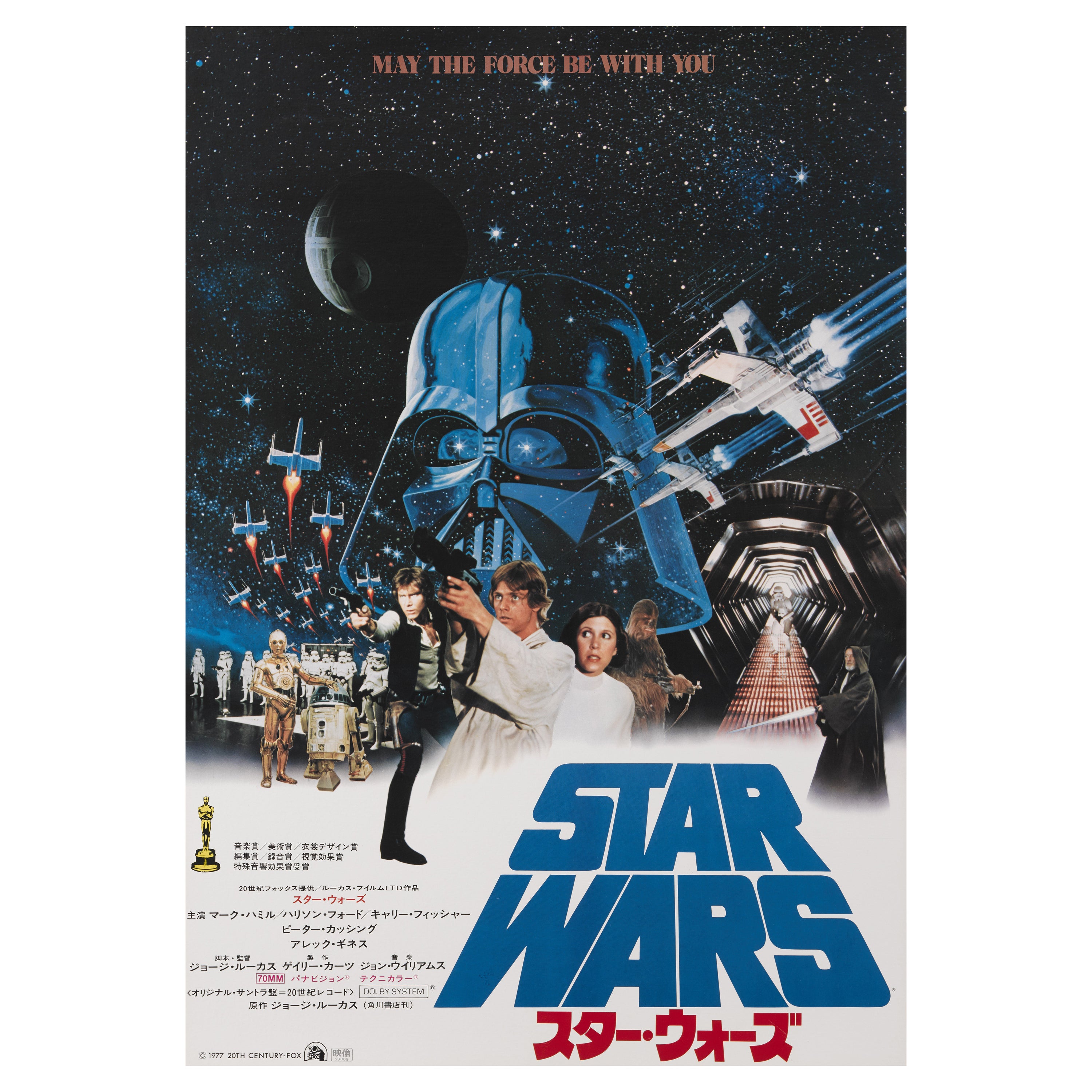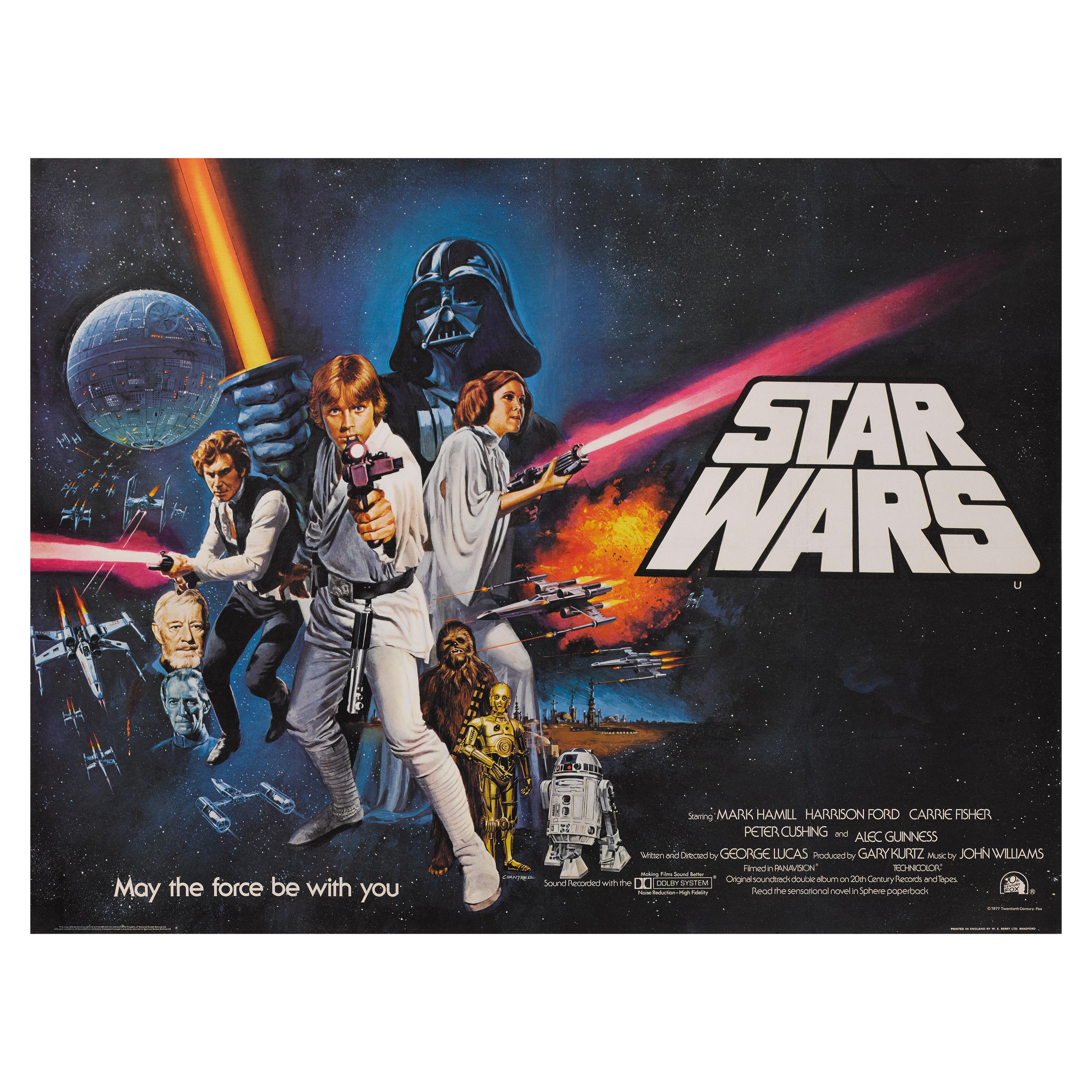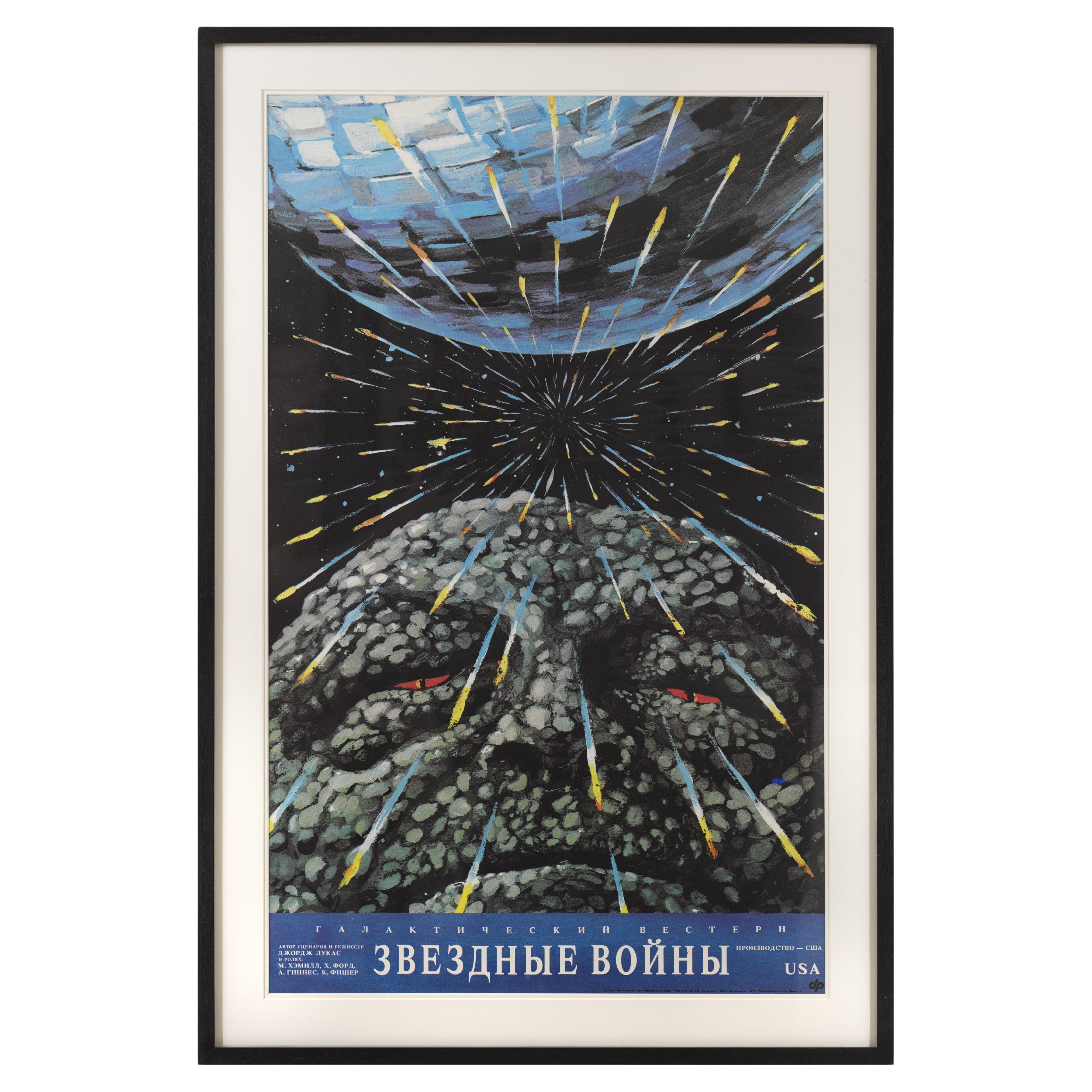Want more images or videos?
Request additional images or videos from the seller
1 of 5
Star Wars
About the Item
Original Japanese film poster for Star Wars 1977.
This poster is unfolded and conservation linen backed in near mint condition. The art work on this poster is by Seito (dates unknown)
The film was directed by George Lucas and starred Mark Hamill, Harrison Ford, Carrie Fisher.
This poster would be shipped rolled in a strong tube and sent by Federal Express.
- Dimensions:Height: 29 in (73.66 cm)Width: 20 in (50.8 cm)Depth: 0.1 in (2.54 mm)
- Materials and Techniques:
- Place of Origin:
- Period:
- Date of Manufacture:1977
- Condition:
- Seller Location:London, GB
- Reference Number:1stDibs: LU989138353352
About the Seller
5.0
Gold Seller
These expertly vetted sellers are highly rated and consistently exceed customer expectations.
Established in 1991
1stDibs seller since 2013
409 sales on 1stDibs
Typical response time: 6 hours
- ShippingRetrieving quote...Ships From: London, United Kingdom
- Return PolicyA return for this item may be initiated within 30 days of delivery.
More From This SellerView All
- Star WarsLocated in London, GBOriginal Japanese film poster this unique design was used for the films Japanese release of the film. The art work is by Seito (dates unknown). This poster is unfolded and conserva...Category
Vintage 1970s Japanese Posters
MaterialsPaper
- Star WarsLocated in London, GBOriginal Russian film posters for Star Wars, 1977. The film was directed by George Lucas and starred Mark Hamill, Harrison Ford, Carrie Fisher. This posters was created for the film'...Category
1990s Russian Posters
MaterialsPaper
You May Also Like
- Canadian Wartime Poster, World War TwoLocated in Hamilton, OntarioCanadian wartime poster, world war two.Category
20th Century Canadian Posters
- U.S. Navy League, "War Clouds Gather!" by Hazel Roberts, Vintage Poster, 1916Located in Colorado Springs, COThis propaganda poster was designed by Hazel Roberts (1883-1966) to encourage onlookers to join the U.S. Navy League. The poster was issued in 1916 and features a depiction of a Navy soldier facing the horizon and playing a bugle. The text at bottom reads "War Clouds Gather! Manhood willing but unarmed. Help the Navy-Join the Navy League/ Local Headquarters." The artist's signature from the lithograph...Category
Vintage 1910s American Historical Memorabilia
MaterialsPaper
- "Let 'Em Have It. Buy Extra Bonds" Vintage WWII 4th War Loan Poster, 1943Located in Colorado Springs, COThis is an original World War II poster, dating to 1943. The poster reads "Let 'Em Have It" and “Buy Extra Bonds” in bold yellow and white block letters. The poster's composition features a soldier throwing a grenade on the battlefield. Black and blue smoked filled skies and barbed wire are seen behind him. The 4th War Loan Shield is illustrated prominently at center left. The poster was illustrated by Bernard Perlin...Category
Vintage 1940s American Posters
MaterialsPaper
- 34-Star Civil War American Flag, Antique Great Star Pattern, circa 1861Located in Colorado Springs, COThe stars of this extremely rare, Civil War-era flag are arranged in what is sometimes called the "Great Flower" pattern, a large star made out of smaller stars -- named as such beca...Category
Antique 1860s American Political and Patriotic Memorabilia
MaterialsLinen
- Star Wars Film-Used Props from Original 1977 FilmLocated in Jersey, GB- Three fibreglass pieces of Krayt Dragon bone that appear in the original 1977 film Star Wars Star Wars, episode IV: A New Hope (1977), written and di...Category
Vintage 1970s Historical Memorabilia
MaterialsFiberglass
- 36 Star American Flag, Civil War Era, Nevada StatehoodLocated in York County, PA36 Stars In The "Great Star" Or "Great Luminary" Pattern On A Civil War Era Flag With A Dusty Blue Canton And A Section Of One Stripe Souvenired, 1864-67, Nevada Statehood 36 star American national flag of the Civil War era, entirely hand-sewn and with some rare and beautiful features. The stars are arranged in a rendition of what is known as the Great Star or Great Luminary configuration, a large star made out of smaller stars. With no official star pattern before 1912, their design was left up to the artistic liberties of the flag-maker. Strikingly visual, the Great Star is both scarce and coveted by collectors. The 36th state, Nevada, entered the Union during the Civil War on October 31st, 1864. The last Confederate general surrendered on May 26th, 1865. The 36 star flag became official on July 4th of that year, but makers of printed flags would have begun adding a 36th star to their flags in 1864, even before the addition of the new state occurred. Lincoln pushed Nevada through just 8 days before the November election. Nevada’s wealth in silver was attractive to a nation struggling with the debts of war and increased support for the Republican ticket. The 36 star flag was replaced by the 37 star flag in 1867, with the addition of Nebraska. Adding to the flag's appeal is its small scale across those with of piece-and-sewn construction. During the 19th century, sewn flags (as opposed to those that were printed on cloth) were typically eight feet long and larger. This is because they were important in their function as signals, meaning that they needed to be seen and recognized from great distance. A flag that was six feet in length was considered small and production of flags smaller than this was extremely limited. Even infantry battle flags were approximately six by six and-one-half feet, about the size of an average quilt of the same period. As time passed, circumstances changed and sewn flags began to find more of a decorative purpose. Smaller flags are more scarce and far easier to frame and display. The Great Star configuration appears to have come about shortly after the War of 1812, when Congressman Peter Wendover of New York requested that Captain Samuel Reid, a War of 1812 naval hero, create a new design that would become the third official format of the Stars & Stripes. A recipient of the Congressional Medal of Honor, Reid became harbor master of New York following the war. During his lifetime, he created many innovations in signal use, including a system that could actually send messages from New York to New Orleans by sea in just two hours. Use as a Naval signal had been the primary reason for the initial creation of an American national flag in 1777, but since there was no official star design, the appearance of our flag varied greatly. Reid’s primary concern centered on both consistency and ease of recognition. His hope was as more and more states joined the Union and more and more stars were added to the flag, that it would remain easily identified on the open seas. In 1818, Reid suggested to Congress that the number of stripes permanently return to 13 (reduced from 15) and that the stars be grouped into the shape of one large star. Reid’s proposal would have kept the star constellation in roughly the same format, in a pattern that could be quickly identified through a spyglass as the number of states grew. His concept for the stripes was ultimately accepted, but his advice on the star pattern was rejected by President James Monroe, due to the increased cost of arranging the stars in what would become known as the “Great Star”, “Great Flower”, or “Great Luminary” pattern. Monroe probably didn’t wish to impose this cost on either the government or civilians, so he suggested a simple pattern of justified rows. Never-the-less, the Great Star was produced by anyone willing to make it and its rarity today, along with its beauty, has driven the desirability of American flags with this configuration. The canton and stripes of the flag are made of fine merino wool. Note how the canton has faded to a dusty seafoam blue, which is endearingly attractive. The stars of the flag are hand-sewn and single-appliquéd. This means that they were applied to one side of the canton, then the blue fabric was cut from behind each star, folded over, and under-hemmed, so that one star could be viewed on both sides of the flag. I always find single-appliquéd stars more interesting, not only because they are evidence of a more difficult level of seam-work and stitching, but also because they are more visually intriguing. The two visible rows of hand-stitching emphasize their hand-sewn construction, which is one reason why flags with single-appliquéd stars often appeal to connoisseurs of early American textiles...Category
Antique 1860s American Political and Patriotic Memorabilia
MaterialsWool





